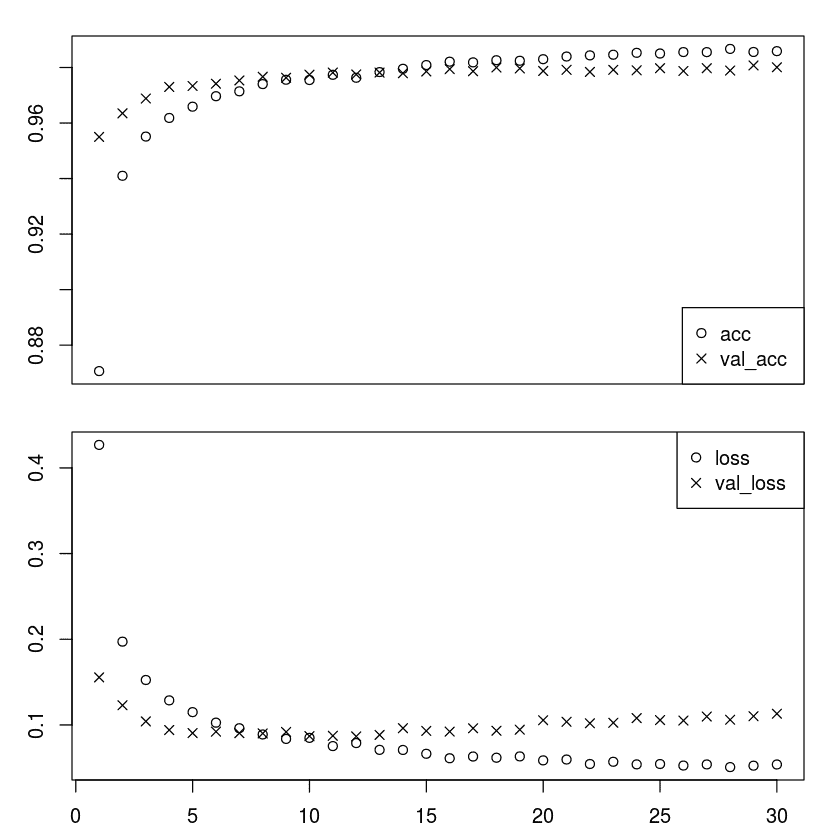R 中的 Keras API
我们在第 3 章中了解了 Keras API。在 R 中,此 API 使用keras R 包实现。 keras R 软件包实现了 Keras Python 接口的大部分功能,包括顺序 API 和函数式 API。
作为示例,我们提供了 MLP 模型的演练,用于在以下链接中对来自 MNIST 数据集的手写数字进行分类: https://keras.rstudio.com/articles/examples/mnist_mlp.html 。
您可以按照 Jupyter R 笔记本中的代码ch-17c_Keras_in_R。
- 首先,加载库:
library(keras)
- 定义超参数:
batch_size <- 128
num_classes <- 10
epochs <- 30
- 准备数据:
# The data, shuffled and split between train and test sets
c(c(x_train, y_train), c(x_test, y_test)) %<-% dataset_mnist()
x_train <- array_reshape(x_train, c(nrow(x_train), 784))
x_test <- array_reshape(x_test, c(nrow(x_test), 784))
# Transform RGB values into [0,1] range
x_train <- x_train / 255
x_test <- x_test / 255
cat(nrow(x_train), 'train samples\n')
cat(nrow(x_test), 'test samples\n')
# Convert class vectors to binary class matrices
y_train <- to_categorical(y_train, num_classes)
y_test <- to_categorical(y_test, num_classes)
注释是不言自明的:数据从 Keras 数据集库加载,然后转换为 2D arrray 并归一化为[0,1]范围。
- 定义模型:
model <- keras_model_sequential()
model %>%
layer_dense(units=256,activation='relu',input_shape=c(784)) %>%
layer_dropout(rate = 0.4) %>%
layer_dense(units = 128, activation = 'relu') %>%
layer_dropout(rate = 0.3) %>%
layer_dense(units = 10, activation = 'softmax')
summary(model)
model %>% compile(
loss = 'categorical_crossentropy',
optimizer = optimizer_rmsprop(),
metrics = c('accuracy')
)
- 定义和编译顺序模型。我们得到的模型定义如下:
_____________________________________________________
Layer (type) Output Shape Param #
=====================================================
dense_26 (Dense) (None, 256) 200960
_____________________________________________________
dropout_14 (Dropout) (None, 256) 0
_____________________________________________________
dense_27 (Dense) (None, 128) 32896
_____________________________________________________
dropout_15 (Dropout) (None, 128) 0
_____________________________________________________
dense_28 (Dense) (None, 10) 1290
=====================================================
Total params: 235,146
Trainable params: 235,146
Non-trainable params: 0
- 训练模型:
history <- model %>% fit(
x_train, y_train,
batch_size = batch_size,
epochs = epochs,
verbose = 1,
validation_split = 0.2
)
plot(history)
拟合函数的输出存储在历史对象中,其包含来自训练周期的损失和度量值。绘制历史对象中的数据,结果如下:
 Training and Validation Accuracy (y-axis) in Epochs (x-axis)
Training and Validation Accuracy (y-axis) in Epochs (x-axis)
- 评估模型:
score <- model %>% evaluate(
x_test, y_test,
verbose = 0
)
# Output metrics
cat('Test loss:', score[[1]], '\n')
cat('Test accuracy:', score[[2]], '\n')
输出如下:
Test loss: 0.1128517
Test accuracy: 0.9816
太酷!!
在以下链接中查找更多关于 Keras in R 的示例:https://keras.rstudio.com/articles/examples/index.html
有关 Keras R 软件包的更多文档可在以下链接中找到:https://keras.rstudio.com/reference/index.html